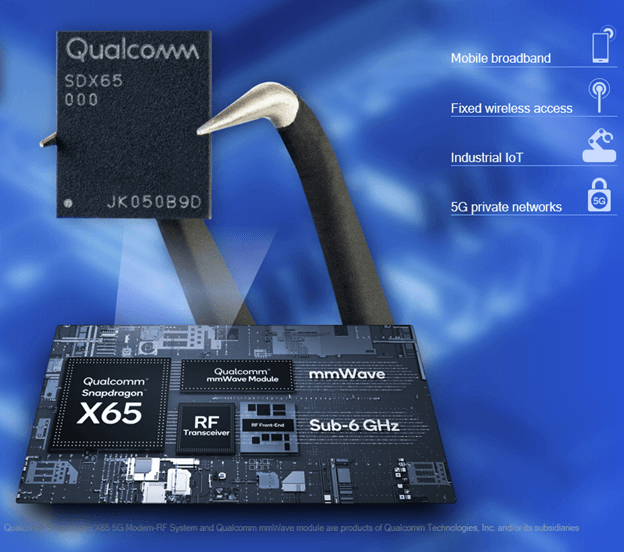Qualcomm today took the wraps off the Snapdragon X65 5G modem, a modem that will be in all of the flagship devices next year and will likely be the last Qualcomm part to find a home in an iPhone.
The new modem, using a fourth-generation 5G modem-to-antenna solution, will likely be part of the 2022 iPhone lineup. From 2023 onwards, Apple is expected to use its own 5G modems instead.

As for this new part, Qualcomm promises a wider mmWave bandwidth for starters.
Extended mmWave capabilities for global expansion with support for wider 200 MHz carrier bandwidth in the mmWave spectrum and mmWave support in standalone (SA) mode. With mmWave commercially deployed by all major operators in the U.S. and Japan, and over 150 global operators investing in these high-band frequencies1, these new mmWave features lay the foundation for driving upcoming rollouts of 5G mmWave in China and other regions along with 5G SA network development. The Snapdragon X65 supports spectrum aggregation of up to 1 GHz of mmWave spectrum and 300 MHz of sub-6 GHz spectrum across FDD and TDD, allowing for unprecedented 5G capacity for networks, and blazing 5G speeds for users.
More important to most users, however, is the fact the new Snapdragon X65 modem will offer improved power efficiency, something that’s vital for smartphones that already draw a ton of power thanks to beefy CPUs.

Improved power efficiency with support for all-day battery life, while enabling significantly better performance through new power-saving technologies within Qualcomm® 5G PowerSave 2.0. Featuring Release 16 UE-Assisted Information (UAI), a power efficiency enhancing technique, the device and base station can now exchange critical information to dynamically and efficiently manage various connection parameters such as number of carriers, allocated bandwidth, layers and thermal performance to optimize network resources for the particular ongoing application or context.
Qualcomm says that it’s currently taking to its customers ahead of a planned launch of the modem towards the end of this year. It will be far too late to make a debut in the iPhone 13, however. That will instead use the Qualcomm Snapdragon X60 modem.
You may also like to check out:
- Download: iOS 14.5.1 IPSW Links, OTA Profile File Along With iPadOS 14.5.1 Released
- Jailbreak iOS 14.5.1 Using Checkra1n, Here’s How-To [Guide]
- How To Downgrade iOS 14.5.1 And iPadOS 14.5.1 [Tutorial]
- How To Fix Bad iOS 14 Battery Life Drain [Guide]
- Convert Factory Wired Apple CarPlay To Wireless Apple CarPlay In Your Car Easily, Here’s How
- iPhone 12 / Pro Screen Protector With Tempered Glass: Here Are The Best Ones
- Best iPhone 12, 12 Pro Case With Slim, Wallet, Ultra-Thin Design? Here Are Our Top Picks [List]
- Best iPhone 12 Mini Screen Protector: Here’s A List Worth Checkin
- Best iPhone 12 Pro Max Screen Protector: Here Is A List Worth Checking
- Apple Watch ECG App Hack: Enable Outside US In Unsupported Country On Series 5 & 4 Without Jailbreak
You can follow us on Twitter, or Instagram, and even like our Facebook page to keep yourself updated on all the latest from Microsoft, Google, Apple, and the Web.

